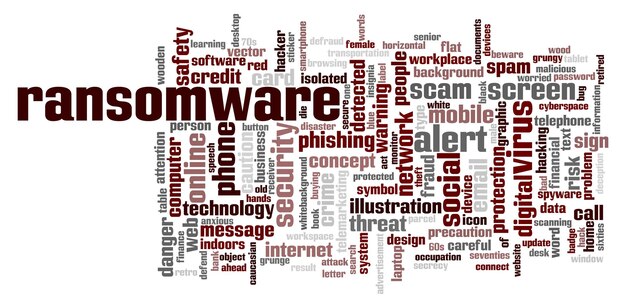National Cybersecurity Alert: New Ransomware Warnings for Critical Infrastructure

A national cybersecurity alert has been issued, highlighting increased ransomware attacks targeting critical infrastructure across the United States, prompting government agencies to release new warnings and guidance.
A national cybersecurity alert has been issued, signaling a heightened risk of ransomware attacks on critical infrastructure. Government agencies are urging organizations to bolster their defenses against these increasingly sophisticated threats. Is your infrastructure prepared?
Understanding the National Cybersecurity Alert
The recent national cybersecurity alert serves as a stark reminder of the ever-present danger posed by ransomware attacks. These attacks, which can cripple essential services and industries, are becoming more frequent and sophisticated, necessitating a proactive and vigilant approach to cybersecurity.
This alert isn’t just another routine warning; it reflects a tangible increase in the threat level, demanding immediate attention and action from organizations responsible for maintaining critical infrastructure.
What Triggers a National Cybersecurity Alert?
National cybersecurity alerts are issued when government agencies, such as the Cybersecurity and Infrastructure Security Agency (CISA), observe a significant or imminent threat to the nation’s digital infrastructure. These threats often involve sophisticated actors, zero-day vulnerabilities, or widespread campaigns that could cause substantial damage.
Why is Critical Infrastructure a Prime Target?
Critical infrastructure, including energy, water, healthcare, and transportation systems, is a prime target for ransomware attacks because these sectors provide essential services. Disruptions can have far-reaching consequences, affecting public safety, the economy, and national security.
- 💰Financial Gain: Ransomware attackers are primarily motivated by financial gain, seeking large ransom payments in exchange for restoring access to compromised systems.
- 🛡️Vulnerabilities: Many critical infrastructure systems have legacy technology and cybersecurity vulnerabilities, making them easier to exploit.
- 🌐Interconnectedness: The interconnected nature of critical infrastructure creates opportunities for attackers to move laterally across networks, amplifying the impact of their attacks.
In summary, understanding the context and triggers behind this alert is the first step in fortifying your defenses and mitigating potential risks. Awareness and proactive measures are crucial to safeguarding critical infrastructure from crippling ransomware attacks.

Key Sectors at Risk
The national cybersecurity alert casts a wide net, but certain sectors are identified as being at particularly high risk. Understanding which sectors are most vulnerable can help organizations prioritize their cybersecurity efforts and allocate resources effectively.
This isn’t about instilling fear; it’s about fostering a culture of awareness and preparedness within these vital sectors.
Energy Sector Vulnerabilities
The energy sector, which includes power plants, oil refineries, and gas pipelines, is a prime target for ransomware attacks due to its critical role in powering the nation. A successful attack could disrupt energy supplies, causing widespread blackouts and economic damage.
Healthcare System Risks
Healthcare systems are increasingly vulnerable, as ransomware attacks can disrupt patient care, compromise sensitive data, and even endanger lives. Hospitals and clinics rely heavily on interconnected systems, making them susceptible to lateral movement by attackers.
- 🚑Patient Safety: Ransomware attacks can disrupt access to medical records, delay treatments, and compromise medical devices, potentially harming patients.
- 🔒Data Breaches: Healthcare organizations store vast amounts of sensitive patient data, making them attractive targets for cybercriminals seeking to steal and sell this information.
- 🏥System Downtime: Attacks that cripple hospital networks can lead to appointment cancellations, emergency room diversions, and overall system disruptions.
In conclusion, assessing the risks facing key sectors is a critical step in defending against ransomware attacks. By understanding the specific vulnerabilities of each sector, organizations can implement tailored security measures and protect their assets effectively.
Analyzing the Latest Ransomware Tactics
To effectively defend against ransomware attacks, it’s essential to understand the evolving tactics used by cybercriminals. The national cybersecurity alert highlights several key trends in ransomware attacks that organizations should be aware of.
By understanding these tactics, organizations can better anticipate and mitigate potential threats.
Double Extortion Techniques
Double extortion involves not only encrypting a victim’s data but also stealing it and threatening to release it publicly if the ransom is not paid. This tactic puts additional pressure on victims to comply with attackers’ demands.
Ransomware-as-a-Service (RaaS) Model
Ransomware-as-a-Service (RaaS) has lowered the barrier to entry for cybercriminals, enabling novice attackers to launch sophisticated ransomware campaigns by purchasing access to ransomware tools and infrastructure from experienced operators.
- 👨💻Accessibility: RaaS platforms provide user-friendly interfaces, allowing even individuals with limited technical skills to launch ransomware attacks.
- 🤝Affiliate Programs: RaaS operators recruit affiliates to distribute ransomware in exchange for a share of the ransom payments.
- 🛠️Comprehensive Tools: RaaS platforms offer a range of tools and services, including ransomware variants, payment processing, and negotiation support.
In summation, understanding these evolving tactics is crucial for organizations to stay one step ahead of ransomware attackers and protect their systems and data from compromise. Continuous monitoring and adaptation are essential to maintain a strong security posture.

Government Recommendations and Guidelines
In response to the heightened ransomware threat, government agencies have issued a range of recommendations and guidelines to help organizations strengthen their cybersecurity posture. The national cybersecurity alert underscores the importance of adhering to these guidelines.
Following these recommendations can significantly reduce organizations’ risk of falling victim to ransomware attacks.
Implementing CISA’s Best Practices
The Cybersecurity and Infrastructure Security Agency (CISA) offers a wealth of resources and best practices for mitigating ransomware risks, including guidelines for vulnerability management, incident response, and data backup and recovery.
Adopting NIST Cybersecurity Framework
The National Institute of Standards and Technology (NIST) Cybersecurity Framework provides a structured approach to managing cybersecurity risks, helping organizations identify, protect, detect, respond to, and recover from cyberattacks.
- 🔑Identify: Understand your organization’s assets, risks, and vulnerabilities.
- 🛡️Protect: Implement security controls to prevent ransomware attacks.
- 🔍Detect: Monitor your systems for signs of intrusion and malicious activity.
- 🚨Respond: Develop and implement an incident response plan to contain and eradicate ransomware attacks.
- 🔄Recover: Restore your systems and data from backups and resume normal operations.
In summary, adhering to government recommendations and guidelines is essential for organizations to effectively protect themselves against ransomware attacks. Proactive measures, continuous monitoring, and incident response planning are key components of a robust cybersecurity strategy.
Steps to Enhance Your Organization’s Cybersecurity
Building a robust cybersecurity posture requires a multi-faceted approach that encompasses technology, policies, and employee training. The national cybersecurity alert serves as a catalyst for organizations to take proactive steps to enhance their defenses.
Effective cybersecurity requires ongoing effort and investment, but the benefits far outweigh the costs.
Conducting Regular Security Audits
Regular security audits can help identify vulnerabilities and weaknesses in your organization’s systems and processes, enabling you to address potential risks before they can be exploited by attackers.
Investing in Employee Training
Employee training is a critical component of cybersecurity, as employees are often the first line of defense against phishing attacks and other social engineering tactics. Training should cover topics such as identifying phishing emails, creating strong passwords, and avoiding suspicious websites and links.
Reinforce these principles regularly through simulated phishing exercises and other awareness campaigns.
In conclusion, taking proactive steps to enhance your organization’s cybersecurity is essential for protecting your assets and maintaining business continuity. By investing in technology, policies, and employee training, you can significantly reduce your risk of falling victim to ransomware attacks.
The Future of Cybersecurity and Ransomware Threats
The cybersecurity landscape is constantly evolving, and organizations must stay abreast of emerging threats and trends to effectively protect themselves. The national cybersecurity alert is a wake-up call, urging organizations to prepare for the future of cybersecurity.
Predicting the future is impossible, but we can anticipate certain trends and prepare accordingly.
Artificial Intelligence and Machine Learning in Cybersecurity
Artificial intelligence (AI) and machine learning (ML) are playing an increasingly important role in cybersecurity, enabling organizations to automate threat detection, incident response, and vulnerability management. AI-powered security tools can analyze vast amounts of data to identify anomalies and malicious activity, helping security teams respond more quickly and effectively.
The Growing Threat of Nation-State Actors
Nation-state actors are becoming increasingly involved in cyberattacks, including ransomware campaigns. These actors have significant resources and expertise, making them capable of launching sophisticated and devastating attacks.
As a closing thought, the future of cybersecurity will require ongoing vigilance, innovation, and collaboration. By staying informed, investing in advanced technologies, and fostering a culture of security awareness, organizations can better protect themselves from the evolving threat of ransomware and other cyberattacks.
| Key Point | Brief Description |
|---|---|
| 🚨 National Alert | Increased ransomware threats require immediate attention. |
| 🛡️ Critical Sectors | Energy, healthcare, and finance are prime targets. |
| 💡 Key Tactics | Double extortion and RaaS models are on the rise. |
| 🏛️ Government Guidance | CISA and NIST provide frameworks for robust cybersecurity. |
Frequently Asked Questions
▼
Ransomware is a type of malicious software that encrypts a victim’s data, rendering it inaccessible. Attackers then demand a ransom payment in exchange for the decryption key needed to restore the data.
▼
Ransomware attacks on critical infrastructure can disrupt essential services such as energy, water, transportation, and healthcare, leading to widespread disruptions and potential safety concerns.
▼
Organizations can protect themselves by implementing strong security measures, including regular backups, employee training, vulnerability patching, and incident response planning.
▼
If your organization is hit, isolate affected systems, report the incident to law enforcement, and consult with cybersecurity experts to develop a recovery plan. Do not immediately pay the ransom.
▼
Yes, small businesses are increasingly targeted by ransomware attackers, as they often lack the resources and expertise to implement robust security measures. Prevention is essential for survival.
Conclusion
In conclusion, the national cybersecurity alert serves as an urgent call to action for organizations across all sectors to prioritize cybersecurity and proactively address the growing threat of ransomware attacks. By understanding the risks, implementing best practices, and staying informed about emerging threats, organizations can strengthen their defenses and protect their critical infrastructure from compromise.





